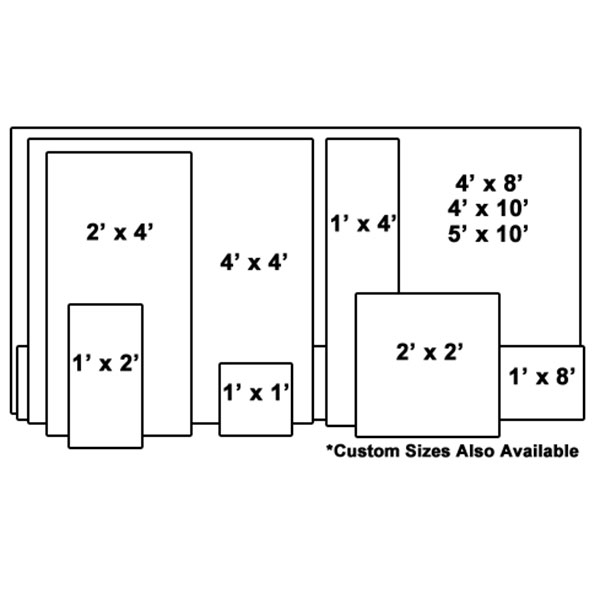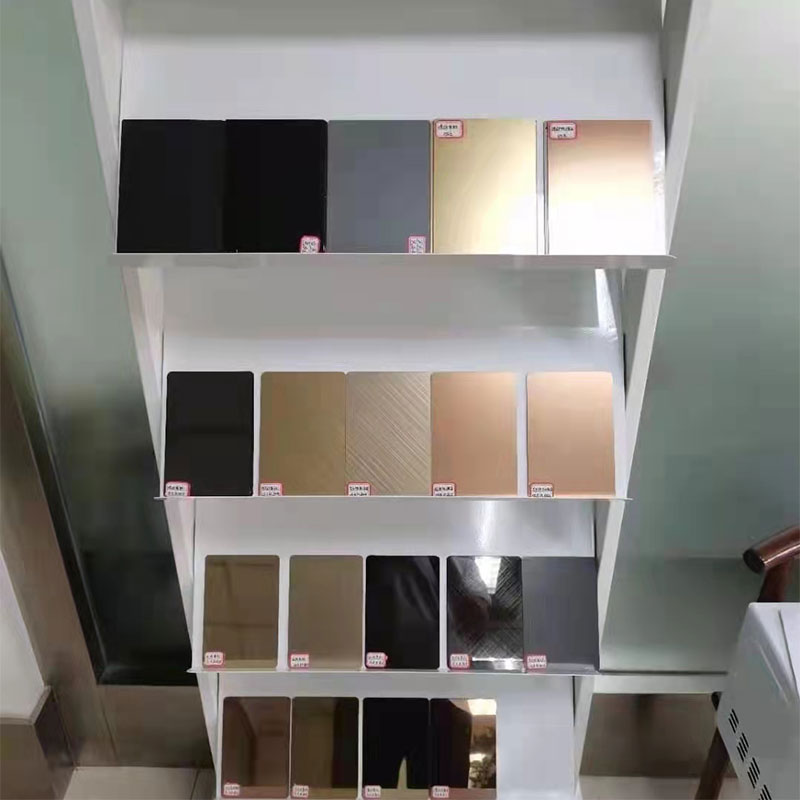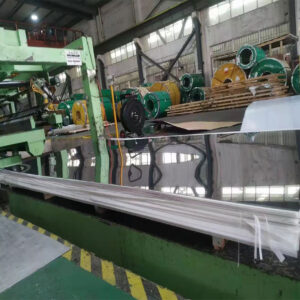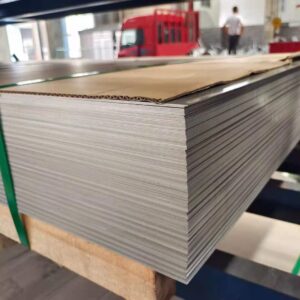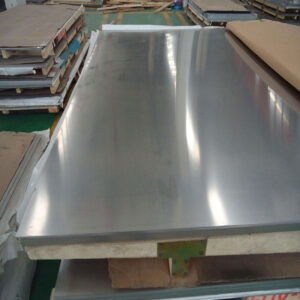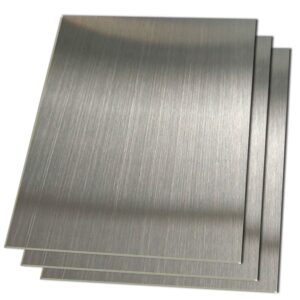Description
309s / 1.4833 Stainless Steel Sheet
Alloy 309/309S (UNS S30900/S30908) austenitic stainless steel is typically used for elevated temperature applications. Its high chromium and nickel content provides comparable corrosion resistance, superior resistance to oxidation, and the retention of a larger fraction of room temperature strength than the common austenitic Alloy 304.
Alternative grades of equivalent materials
| China * GB | GB24511 | 06Cr23Ni13 |
| Japan | JIS | SUS309S |
| United States of America | ASTM | 309S |
| UNS | S30908 | |
| South Korea | KS | STS309S |
| European Union | BSEN | 1.4833 |
| India | IS | – |
| Australia | AS | 309S |
| Taiwan, China | CNS | 309S |
| Germany | DIN | X12CrNi23-13 |
| United Kingdom | BS970 BS1449 | – |
| Belgium | BS970Part1 | – |
General Properties
Alloy 309 (UNS S30900) is an austenitic stainless steel developed for use in high temperature corrosion resistance applications. The alloy resists oxidation up to 1900°F (1038°C) under non-cyclic conditions. Frequent thermal cycling reduces oxidation resistance to approximately 1850°F (1010°C).
Because of its high chromium and low nickel content, Alloy 309 can be utilized in sulfur containing atmospheres up to 1832°F (1000°C). The alloy is not recommended for use in highly carburizing atmospheres since it exhibits only moderate resistance to carbon absorption. Alloy 309 can be utilized in slightly oxidizing, nitriding, cementing and thermal cycling applications, albeit, the maximum service temperature must be reduced.
When heated between 1202 – 1742°F (650 – 950°C) the alloy is subject to sigma phase precipitation. A solution annealing treatment at 2012 – 2102°F (1100 – 1150°C) will restore a degree of toughness.
309S (UNS S30908) is the low carbon version of the alloy. It is utilized for ease of fabrication. 309H (UNS S30909) is a high carbon modification developed for enhanced creep resistance. It most instances the grain size and carbon content of the plate can meet both the 309S and 309H requirements.
Alloy 309 can be easily welded and processed by standard shop fabrication practices.
Applications
- Furnaces — burners, doors, fans, piping and recuperators
- Fluidized Bed Furnaces — grids, piping, wind boxes
- Paper Mill Equipment
- Petroleum Refining — catalytic recovery systems, recuperators
- Power Generation — pulverized coal burners, tube hangers
- Thermal Processing — annealing covers and boxes, burners grids, doors, fans, lead pans and neutral salt pots, muffles and retorts, recuperators, walking beams
- Waste Treatment — incinerators, rotary kilns and calciners
Standards
ASTM……..A 240
ASME……..SA 240
AMS……….5523
Corrosion Resistance
Wet Corrosion
Alloy 309 is not designed for service in wet corrosive environments. The high carbon content, which is present to enhance creep properties, has a detrimental effect on aqueous corrosion resistance. The alloy is prone to intergranular corrosion after long term exposure at high temperatures. However, due to its high chromium content (23%), Alloy 309 is more corrosion resistant than most heat resistant alloys.
High Temperature Corrosion
Alloy 309 resists high temperature corrosion in most in-service conditions. Operating temperatures are as follows:
Oxidizing conditions (max. sulfur content – 2 g/m3)
1922°F (1050°C) continuous service
2012°F (1100°C) peak temperature
Oxidizing conditions (max. sulfur greater than 2 g/m3)
1742°F (950°C) maximum temperature
Low oxygen atmosphere (max. sulfur content – 2 g/m3)
1832°F (1000°C) maximum temperature
Nitriding or carburizing atmospheres
1562 –1742°F (850 – 950°C) maximum
The alloy does not perform as well as Alloy 600 (UNS N06600) or Alloy 800 (UNS N08800) in reducing, nitriding or carburizing atmospheres, but it does outperform most heat resistant stainless steels in these conditions.
Creep Properties
Typical Creep Properties
| Temperature | Creep Strain (MPa) | Creep Rapture (MPa) | |||||
|---|---|---|---|---|---|---|---|
| °C | °F | 1000 H | 10000 H | 100000 H | 1000 H | 10000 H | 100000 H |
| 600 | 1112 | 120 | 80 | 40 | 190 | 120 | 65 |
| 700 | 1292 | 50 | 25 | 20 | 75 | 36 | 16 |
| 800 | 1472 | 20 | 10 | 8 | 35 | 18 | 7.5 |
| 900 | 1652 | 8 | 4 | 3 | 15 | 8.5 | 3 |
| 1000 | 1832 | 4 | 2.5 | 1.5 | 8 | 4 | 1.5 |
Chemical Analysis
Weight % (all values are maximum unless a range is otherwise indicated)
| Element | 309 | 309S | 309H |
|---|---|---|---|
| Chromium | 22.0 min.-24.0 max. | 22.0 min.-24.0 max. | 22.0 min.-24.0 max. |
| Nickel | 12.0 min.-15.0 max. | 12.0 min.-15.0 max. | 12.0 min.-15.0 max. |
| Carbon | 0.20 | 0.08 | 0.04 min.-0.10 max. |
| Manganese | 2.00 | 2.00 | 2.00 |
| Phosphorus | 0.045 | 0.045 | 0.045 |
| Sulfer | 0.030 | 0.030 | 0.030 |
| Silicon | 0.75 | 0.75 | 0.75 |
| Iron | Balance | Balance | Balance |
Physical Properties
| Density | Thermal Conductivity 212°F (100°C) |
| 0.285 lbs/in3 | 9.0 BTU/hr/ft2/ft/°F |
| 7.89 g/cm3 | 15.6 W/m-°K |
| Specific Heat | Melting Range |
| 0.12 BTU/lb-°F (32 – 212°F) | 2500 – 2590°F |
| 502 J/kg-°K (0 – 100°C) | 1480 – 1530°C |
| Modulus of Elasticity | Electrical Resistivity |
| 28.5 x 106 psi | 30.7 Microhm-in at 68°C |
| 193 GPa | 78 Microhm-cm at 20°C |
Mechanical Properties
Typical Values at 68°F (20°C)
| Yield Strength 0.2% Offset |
Ultimate Tensile Strength |
Elongation in 2 in. |
Hardness | ||
|---|---|---|---|---|---|
| psi (min.) | (MPa) | psi (min.) | (MPa) | % (min.) | (max.) |
| 45,000 | 310 | 85,000 | 586 | 50 | 202 (HBN) |
Fabrication Data
Alloy 309 can be easily welded and processed by standard shop fabrication practices.
Hot Forming
Heat uniformly at 1742 – 2192°F (950 – 1200°C). After hot forming a final anneal at 1832 – 2101°F (1000 – 1150°C) followed by rapid quenching is recommended.
Cold Forming
The alloy is quite ductile and forms in a manner very similar to 316. Cold forming of pieces with long-term exposure to high temperatures is not recommended since the alloy is subject to carbide precipitation and sigma phase precipitants.
Welding
Alloy 309 can be readily welded by most standard processes including TIG, PLASMA, MIG, SMAW, SAW and FCAW.
Contact Us Now!
Our products: stainless steel including all sizes of steel coils, steel sheets, steel pipes, flat steel, angle steel, round steel, channel steel and other metal materials.
If you need product information or price, please fill in your contact information in the form below, we will usually contact you within 12 hours. You can also click on our email address info@sinosteel.ltd to send us an email to get prompt reply.
Send me the inquiry,free samples and the most favorable quotation are waiting for you!
Supply Better Material for Project & Find Best Solution for Clients
Wish your business boom and all the best!

